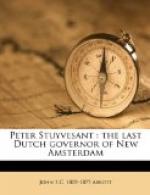Where the gloomy prison of the Tombs now stands, there was a lake of crystal water, overhung by towering trees. Its silence and solitude were disturbed only by the cry of the water-fowl which disported upon its surface, while its depths sparkled with the spotted trout. The lake emptied into the Hudson river by a brook which rippled over its pebbly bed, along the present line of Canal street. This beautiful lake was fed by large springs and was sufficiently deep to float any ship in the navy. Indeed it was some time before its bottom could be reached by any sounding line.
There was a gentle eminence or ridge, forming as it were the backbone of the island, along which there was a narrow trail trodden by the moccasined feet of the Indian, in single file for countless generations. Here is now found the renowned Broadway, one of the busiest thoroughfares upon the surface of the globe.
On the corner of Grand street and Broadway, there was a well-wooded hill, from whose commanding height one obtained an enchanting view of the whole island with its surrounding waters. Amidst these solitudes there were many valleys in whose peaceful bosoms the weary of other lands seemed to be invited to take refuge.
Indeed it is doubtful whether the whole continent of North America presented any region more attractive. The salubrity of its clime, the beauty of the scenery, the abundance and purity of the waters, the spacious harbor, the luxuriance of the soil and the unexplored rivers opening communication with vast and unknown regions of the interior, all combined in giving to the place charms which could not be exceeded by any other position on the continent.
The success of the first trading vessel was so great that, within three years, five other ships were sent to the “Mauritius river” as the Hudson was first named. There was thus opened a very brisk traffic with the Indians which was alike beneficial to both parties. Soon one or two small forts were erected and garrisoned on the river for the protection of the traders. Manhattan island, so favorably situated at the mouth of the river, ere long became the headquarters of this commerce. Four log houses were built, it is said, upon the present site of 39, Broadway.
Here a small company of traders established themselves in the silence and solitude of the wilderness. Their trading boats ran up the river, and along the coast, visiting every creek and inlet in the pursuit of furs. The natives, finding this market thus suddenly opening before them, and finding that their furs, heretofore almost valueless, would purchase for them treasures of civilization of almost priceless worth, redoubled their zeal in hunting and trapping.
A small Indian settlement sprang up upon the spot. Quite large cargoes of furs were collected during the winter and shipped to Holland in the spring. The Dutch merchants seem to have been influenced by a high sentiment of honor. The most amicable relations existed between them and the Indians. Henry Christiaensen was the superintendent of this feeble colony. He was a prudent and just man, and, for some time, the lucrative traffic in peltry continued without interruption. The Dutch merchants were exposed to no rivalry, for no European vessels but theirs had, as yet, visited the Mauritius river.




